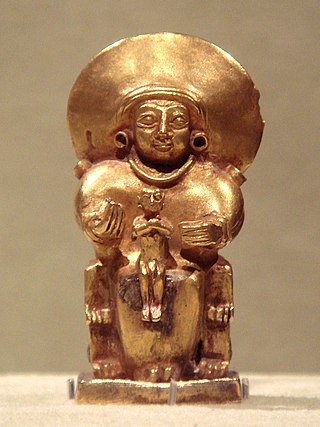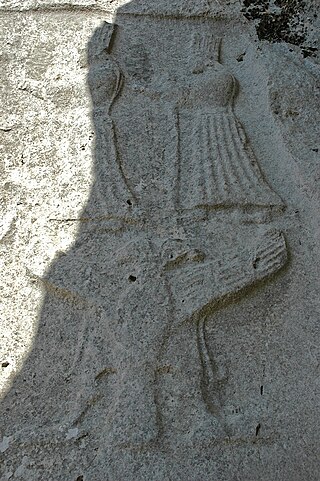Related Research Articles
Ḫašamili was a god worshiped in Bronze Age Anatolia. He originated in religious beliefs of the Hattians, and later came to be incorporated into the Hittite, Palaic and Luwian pantheons. He was regarded as a protective household deity, and was additionally associated with metalworking. He appears in the myth of Ḫaḫḫima, but his role in it is not fully understood.
Kamrušepa was a Hittite and Luwian goddess of medicine and magic, analogous to Hattic and Palaic goddess Kataḫzipuri. She is best known as one of the deities involved in the Telepinu Myth, in which her actions were crucial to pacify the anger of the "missing" vegetation god.
Ḫalmašuit was a goddess worshiped by Hattians and Hittites in Bronze Age Anatolia. She was the divine representation of a ceremonial throne, and acted as both an embodiment of royal authority and as a protective deity of kings.

Hittite mythology and Hittite religion were the religious beliefs and practices of the Hittites, who created an empire centered in what is now Turkey from c. 1600–1180 BC.
Ḫapantali, also known as Ḫapantaliya, was a Luwian goddess who functioned as a divine shepherd. She was also incorporated into Hattian and Hittite beliefs. She is first attested in the Old Assyrian period, and later continued to be worshiped until the fall of the Hittite Empire. She appears in a variety of texts, including descriptions of festivals, treaties, and myths. While in ritual texts she was often linked with Inar, in mythological context she instead could be designated as a helper of Kamrušepa or her husband Tiwad.
Ḫatepuna or Ḫatepinu was a Bronze Age Anatolian goddess of Hattian origin, also worshiped by Hittites and Kaška. She was regarded as the wife of Telipinu, and like him was likely an agricultural deity. In a different tradition, her husband was the male form of the grain deity Ḫalki. It is presumed that she can be identified with the anonymous "daughter of the sea" who appears in two Hittite myths.

The Sun goddess of Arinna, also sometimes identified as Arinniti or as Wuru(n)šemu, is the chief goddess and companion of the weather god Tarḫunna in Hittite mythology. She protected the Hittite kingdom and was called the "Queen of all lands." Her cult centre was the sacred city of Arinna.
The Sun goddess of the Earth was the Hittite goddess of the underworld. Her Hurrian equivalent was Allani and her Sumerian/Akkadian equivalent was Ereshkigal, both of which had a marked influence on the Hittite goddess from an early date. In the Neo-Hittite period, the Hattian underworld god, Lelwani was also syncretised with her.
The Weather god of Zippalanda was a Hittite weather god, who was worshipped in the Hittite city of Zippalanda. The weather god of Zippalanda had several names, such as Ziplantil, Wašezzili, Wašezzil and Wašezzašu.
Anna was the main deity of Kanesh, an Anatolian city which in the Old Assyrian period served as an Assyrian trading colony. Multiple possibilities regarding her origin have been considered by researchers. A temple, festivals and clergy dedicated to her are attested in texts from her city, and in contracts she appears alongside the Assyrian god Ashur. At some point her position declined, and an unidentified weather god became the main local deity instead. It is nonetheless assumed that she continued to be worshiped later on by Hittites and Luwians. It has also been proposed that a deity from Emar can be identified with her, though not all researchers share this view.

Allanzu, later known under the name Alasuwa, was a Hurrian goddess regarded as a daughter of Ḫepat. She was described as a youthful deity and in known texts often appears in association with her mother and siblings. She was also worshiped by Hittites and Luwians.
Ziparwa, originally known as Zaparwa, was the head of the pantheon of the Palaians, inhabitants of a region of northern Anatolia known as Pala in the Bronze Age. It is often assumed that he was a weather god in origin, though he was also associated with vegetation. Information about the worship of Ziparwa comes exclusively from Hittite texts, though some of them indicate that formulas in Palaic were used during festivals dedicated to him held in Hittite cities such as Hattusa.
Taru was a weather god worshiped in ancient Anatolia by Hattians. He was associated with the bull, and could be depicted in the form of this animal. It is presumed that the names of the Hittite and Luwian weather gods, Tarḫunna and Tarḫunz, while etymologically Indo-European, were meant to resemble Taru's as a result of Hattian cultural influence on other cultures of the region.
Ḫalki was the Hittite deity of grain. While it is commonly assumed the name consistently referred to a goddess, a male form of this deity has also been identified. Ḫalki was associated with other grain deities, namely Mesopotamian Nisaba and Hattian Kait, with the latter presumed to be functionally identical. The oldest attestations come from Kanesh, though they are limited to theophoric names. In later periods, the female form of Ḫalki was worshiped in Hattusa, and the male one in Nerik, though evidence from other cities is also available.
Tiyaz or Tiyad was the sun god of the Palaians, regarded as the third most important deity in their pantheon. He was also incorporated into Hittite religion. He appears in a ritual written in Palaic, though presumed to belong to a Hittite corpus, in which he is implored to anoint the king. After the fall of the Hittite Empire, he might have been worshiped by Phrygians.
Šulinkatte was a Hittite god of Hattian origin. He was regarded as a war deity. Additionally, he could fulfill the role of a protector of palaces and houses. In the local tradition of Nerik, he was regarded as the father of the weather god of Nerik. He first appears in texts dated to the fifteenth or fourteenth century BCE. His main cult center was the sparsely attested city Tamarmara, but he was also worshiped elsewhere in ancient Anatolia, for example in Hattusa and Nerik. Fragments of a Hattic song celebrating him are also known.
Wurunkatte or Wurukatte was a Hittite war god of Hattian origin. He might have also been connected to the institution of kingship. His symbol was a mace, and based on textual sources it is presumed he could be depicted standing on the back of a lion. In known texts, he appears in association with deities such as Šulinkatte, Taru and Telipinu. He was worshiped in Hattusa, Nerik, Tuḫumijara and Tarammeka.
Kataḫḫa or Kataḫḫi was a name or title of multiple goddesses worshiped in ancient Anatolia by Hattians and Hittites, with the best known example being the tutelary deity of Ankuwa. It has been proposed that goddesses sharing this name were associated with nature and wildlife.
Ammamma was the name of multiple Hattian and Hittite goddesses worshiped in central and northern Anatolia in the Bronze Age. The best attested Ammamma served as the tutelary goddess of Taḫurpa near Hattusa, and appears in multiple treaties between Hittite kings and foreign rulers.
Kataḫzipuri was a goddess worshiped by Hattians, Hittites and Palaians in Bronze Age Anatolia. She was associated with magic, and was commonly invoked in rituals dealing with healing and purification. She was closely associated with Kamrušepa. In Palaic religion she formed a pair with Ziparwa and headed the pantheon alongside him.
References
- 1 2 3 4 5 Taracha 2009, p. 46.
- 1 2 Corti 2018, p. 43.
- ↑ Haas 1994, p. 475.
- 1 2 3 Popko 2007, p. 67.
- 1 2 3 4 Taracha 2009, p. 57.
- ↑ Taracha 2009, p. 84.
- ↑ Taracha 2009, p. 96.
- ↑ Taracha 2009, pp. 95–96.
- ↑ Haas 1994, p. 586.
- ↑ Haas 1994, p. 426.
- 1 2 Taracha 2009, p. 166.
- ↑ Taracha 2009, pp. 165–166.
- ↑ Haas 1994, p. 611.
- ↑ Haas 1994, pp. 438–439.
Bibliography
- Corti, Carlo (2018). "Along the Road to Nerik: Local Panthea of Hittite Northern Anatolia". Die Welt des Orients. 48 (1). Vandenhoeck & Ruprecht (GmbH & Co. KG): 24–71. doi:10.13109/wdor.2018.48.1.24. ISSN 0043-2547. JSTOR 26551707. S2CID 134880821 . Retrieved 2024-01-11.
- Haas, Volkert (1994). Geschichte der hethitischen Religion. Handbook of Oriental Studies. Section 1: The Near and Middle East (in German). Brill. ISBN 978-90-04-29394-6 . Retrieved 2024-01-11.
- Popko, Maciej (2007). "Zur luwischen Komponente in den Religionen Altanatoliens". Altorientalische Forschungen (in German). 34 (1–2). doi:10.1524/aofo.2007.34.12.63. ISSN 2196-6761.
- Taracha, Piotr (2009). Religions of Second Millennium Anatolia. Dresdner Beiträge zur Hethitologie. Vol. 27. Wiesbaden: Harrassowitz Verlag. ISBN 978-3447058858.